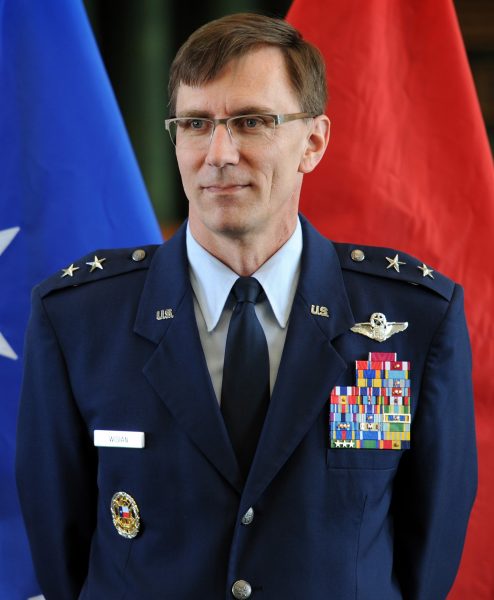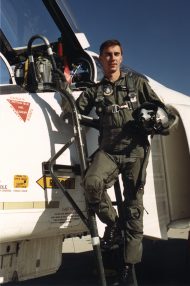Ken Wisian: Associate Director, Environmental Division
November 12, 2020

By Anton Caputo
Ken Wisian is a retired general, a geophysics expert and — most recently — the associate director of the Environmental Division at the Bureau of Economic Geology. From natural disaster preparedness to geothermal energy, he sees big opportunities for applying bureau expertise to some of the world’s most pressing issues.
Succinctly summing up Ken Wisian is not a simple task. By his own admission he’s lived something of a split life. He spent 33 years in the U.S. Air Force, flying as a navigator and retiring as a major general. Along the way, he carved out a career as a scientist, earning a Ph.D. from Southern Methodist University in geophysics, serving as deputy director of the Texas General Land Office and playing leading roles in major initiatives in disaster analytics and geothermal energy.
At the moment, Wisian describes himself as a “happy nerd” who is thrilled to have joined the Bureau of Economic Geology as the associate director of the Environmental Division.
Wisian started his new position in May 2020, replacing Michael Young, who is returning to the role of senior research scientist. He moved to the bureau from the The University of Texas at Austin Cockrell School of Engineering’s Center for Space Research, where he was executive director of the Disaster Research Program. Disaster research is one of Wisian’s main fields of study along with geothermal energy. But he said what really drew him to the bureau was the impressive breadth of important issues that the environmental division tackles.
“When you see what the Environmental Division of the bureau is in — carbon capture, water resources modeling, induced seismicity — these are all hot topics, and they’re doing tremendous public good,” he said. “This is very exciting to me.”

In his new role, Wisian sees his military experience helping him bring together interdisciplinary teams to tackle big problems. That’s the kind of organizational focus that makes Wisian a natural for the new position, said bureau Director Scott Tinker.
“He brings a terrific sense of organization and leadership, a strong background in science, with a current personal focus on geothermal, and broadens our administrative skill sets,” Tinker said. “As a bonus, he has a great sense of humor!”
The last comment is a nod to Wisian’s personality, which Wisian readily admits might run counter to what people expect when they first meet him.
“People assume that, being a retired general, I’m a firebreathing dragon,” he said with a laugh. “I’m actually a pretty easy-going guy.”
Wisian said he believes his specialties fit in perfectly with the bureau’s work. The bureau, for instance, already plays a leading role in several areas of science that help prepare for and respond to disasters. Bureau scientists are particularly active in monitoring coastal ecosystems and communities, collecting data vital for understanding the impact of hurricanes and floods.
Bureau Senior Research Scientist Jeff Paine first met Wisian while working on these issues, when Wisian was deputy director at the Texas General Land Office. Paine had a positive first impression and said he’s not surprised that Wisian has hit the ground running at the bureau.
“I was impressed with his grasp of major coastal issues facing Texas, his eagerness to listen and gather information, and his perceptive suggestions for areas of critical research need,” Paine said. “In his short time at the bureau, he has already demonstrated his managerial gifts to solicit input, offer constructive observations, clear administrative hurdles and enthusiastically encourage those with whom he works. We look forward to helping him expand the bureau’s research breadth.”
Wisian sees a lot of “low hanging fruit” for the bureau when it comes to disasters, like creating better flooding predictions on the Texas coast during hurricanes. Ultimately, he wants to help create a disaster analytics research center, a project he is working on with Clint Dawson at UT’s Oden Institute for Computational Engineering and Sciences. Wisian gained significant experience in disaster zones as a first responder, including during Hurricane Katrina and the space shuttle Columbia disaster. He said that although collecting data is crucial, there’s a gap when it comes to making use of that data.
“There are petabytes of data generated and collected during the disaster, but we use maybe 1% of the information,” he said. “Our goal is not to actually be the data repository but to make use of that data, applying modern big data tools, machine learning and such to produce — to use a military term — ‘actionable information’ for everything from the individual citizen up through a government decision maker.”
Geothermal is another of Wisian’s passions. He is the geosciences lead on the Department of Energy-sponsored Geothermal Entrepreneurship Organization, an innovation-focused project led by UT. The project seeks to build on current drilling technology in the oil and gas industry to make carbon-free geothermal energy available worldwide. This would be done by building closed-loop or semi-open loop systems to circulate a fluid and capture the heat of the planet’s core to generate electricity. The goal is to enable economically viable drilling at temperatures of 660 degrees Fahrenheit (350 Celsius) and at depths of 30,000 feet (about 10 kilometers) within a decade.
The bureau really hits a sweet spot for this project, he said, and can play a key role in helping the oil and gas industry pivot to a new energy source that could be a perfect fit for its technology and workforce skills, as well as bringing together the earth science and engineering disciplines needed for the research and development to enable this paradigm shift.
“Our ability to put together multidisciplinary teams with all of our knowledge sets really gives us the ability to characterize the subsurface N-dimensionally for this new wave of geothermal,” he said. “Obviously just knowing the temperature at depth is a big deal, but you need to know the stress regime, the permeability and pressure structure, and lithology, and then to monitor the projects through seismicity. That’s something we can do as well as anybody in the world.”
Back to the Newsletter